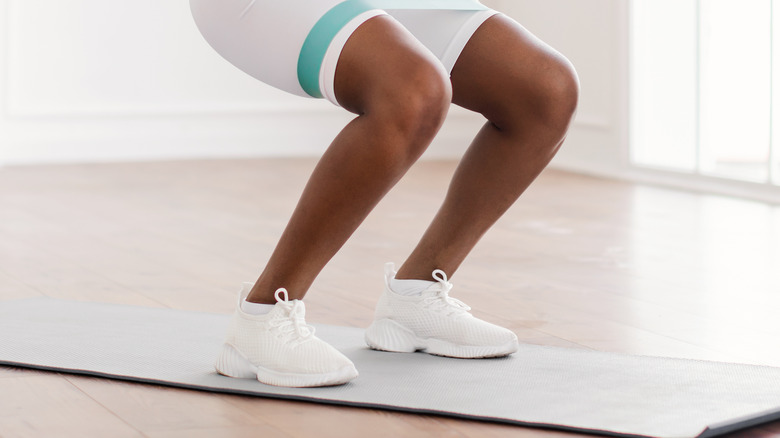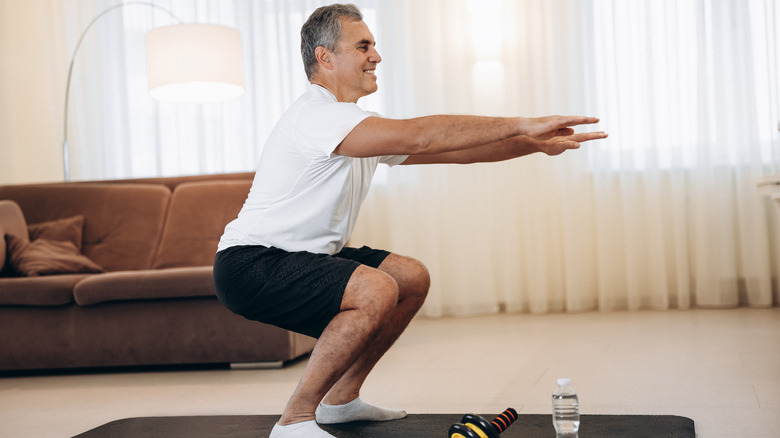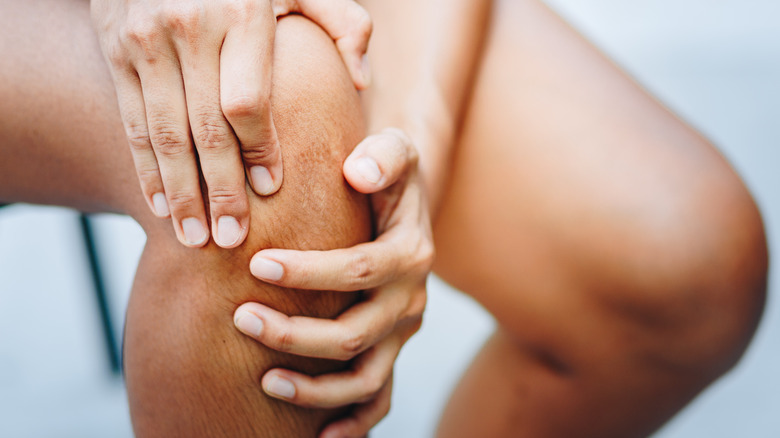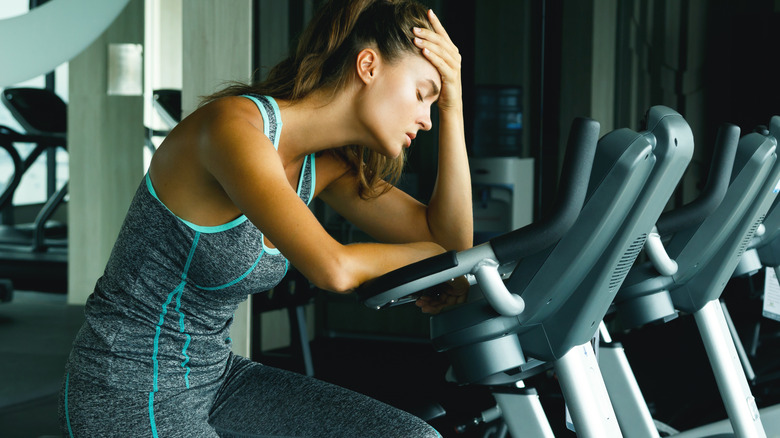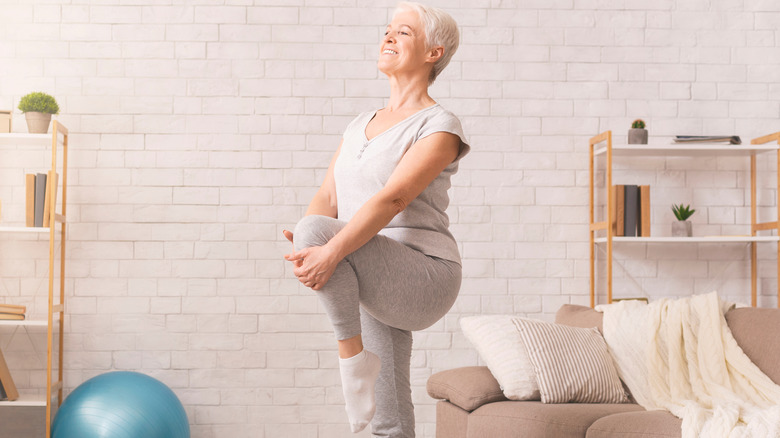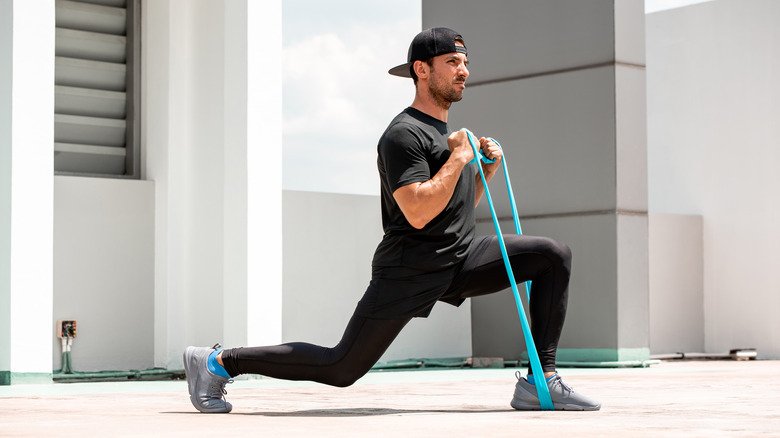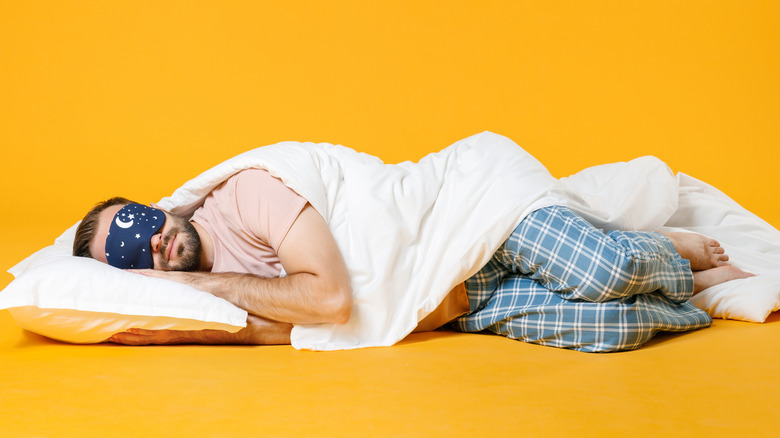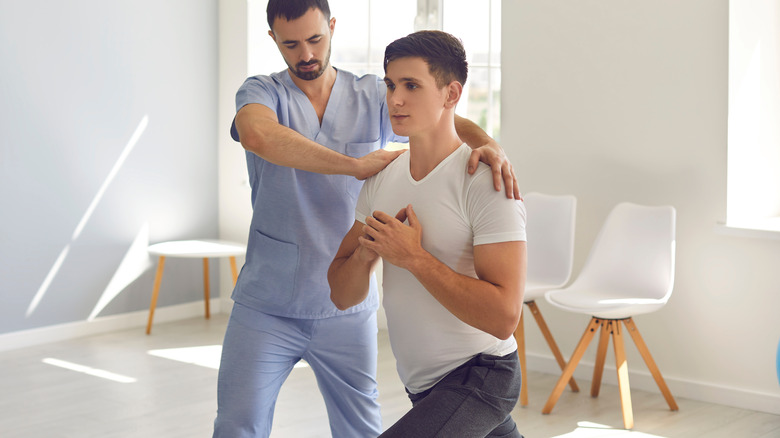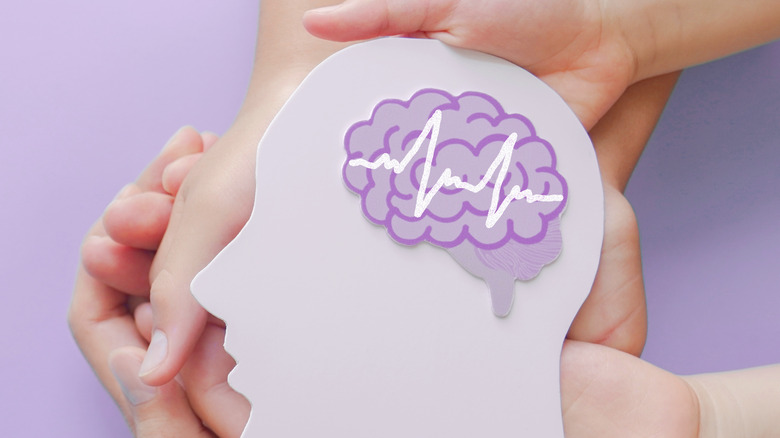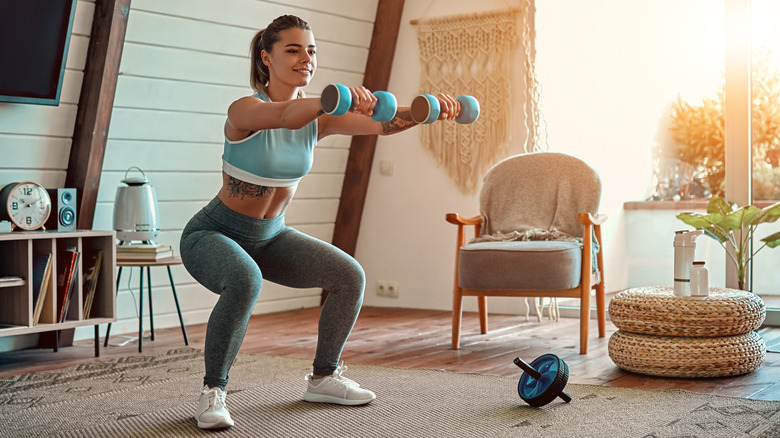When You Do Leg Workouts Every Day, This Is What Happens To You
Few things divide opinion as much as leg day. For some people, going hard on their legs in the gym is the epitome of a productive workout. Yet for others, it strikes fear into the heart. But there's a very good reason why you shouldn't be skipping leg days, not least because of your legs' involvement in pretty much every physical activity (for which strength and conditioning is essential).
"Everything starts at the ground, moving from your ankles, knees and hips to your upper body," advises Michigan-based Xceleration Sports owned Ben Boudro (via Stack). "Your legs are your foundation. The stronger your foundation, the stronger and faster you will be in your skills."
But while working out your legs regularly is a vital part of any workout routine, it's easy to get enthusiastic. And once you start embracing leg day, you may not be able to stop. The question, though, is: Can you work out your legs too much? And what happens if you're working your legs out every day? Here at Health Digest, we wanted to take some steps (get it?) in investigating what the consequences of daily leg workouts could look like, so join us as we squat, lunge, and hop our way through everything you need to know.
Your bones may get stronger
When you work out your legs every day, it's not just your muscles that will get stronger. Turns out, your bones may do so too.
Performing strength-based workouts involving your legs can help to reduce bone cell loss and the prevalence of developing osteoporosis, according to physical therapist Chantal Donnelly (via Everyday Health). When you practice strength training, you place stress on your bones, thereby prompting your body to produce more bone cells. This, in turn, strengthens your bones and helps prevent bone injuries. Regular resistance training can help to improve your bone density at a rate of "about 1% per year," says National Osteoporosis Foundation spokeswoman and Helen Hayes Hospital's Clinical Research Center medical director Felicia Cosman.
Just bear in mind, however, that if you already have osteoporosis, working out intensely every day may not be the best course of action. Although it's important to continue with regular physical activity if you have osteoporosis, it's advised to keep your muscle strengthening exercise sessions to around 2-3 per week and on non-consecutive days (per the Royal Osteoporosis Society). It's always a smart idea to check with your doctor before starting any new exercise regime, particularly if you're looking to work out every day.
Working out your legs every day will stimulate hormone release
We tend to associate our hormones with certain stages of our lives. However, they're actually constantly performing functions in our bodies, from regulating our mood and appetite to being involved in maintaining sexual function (via Everyday Health). And although we tend to think of them as working away in the background, their balance can be affected by many of our daily behaviors and lifestyle factors.
This includes exercise, particularly those that involve our legs. As it turns out, performing leg workouts can provoke the release of larger amounts of certain hormones into our bloodstream, per Healthline. Among the hormones that are stimulated to be released is testosterone, which is vital in helping build muscle and repair and strengthen damaged muscle tissue (providing you with those rock-hard glutes and quads), and human growth hormone (or HGH), which helps your muscles get bigger and stronger while boosting your metabolic rate and immunity. Meanwhile, cortisol (also called the stress hormone) helps manage your body's stress response and regulate your sleep cycle and blood pressure, according to WebMD.
Leg workouts can help support other exercises
Leg workouts will ... and hold your breath, folks, because this will come as a big shock ... strengthen your legs. We know. Wild. But in doing that, you're not just going to see the benefit through having more shapely calves and hamstrings: All of that strength is going to stand you in good stead the next time you perform other exercises.
This is particularly the case if you're a runner, as MedicineNet states. Incorporating resistance exercises into your workout repertoire can help your hips become stronger, which can help to safeguard against the hip injuries commonly experienced by runners due to the increased stress the exercise places the area under (per Healthline). Building up leg strength has also been observed to increase performance in athletes by providing more capacity to generate power through the lower half of the body. And beyond improving your performance when you're exercising, having stronger legs will help you in pretty much every daily activity, whether it's carrying your groceries or moving to a new house. Your arms might be strong, but don't underestimate the importance of having strong legs and glutes in your regular activities.
Your legs will get stronger if you work them out every day
Yes. We know. We're sorry to point out the extremely obvious. But it does bear saying that the natural result of working your legs out every day is that, well, they'll get stronger! When you work out your legs, you're challenging your muscles and eventually overloading them, and when this happens, your muscle fibers become damaged (per Medical News Today). Your body then goes to work repairing these muscles, recruiting hormones released through exercise to do so. This makes your muscles bigger and stronger.
If you want to take your leg workout game to the next level, it's important to continue challenging your legs by keeping your exercise sessions productive and intense, advises pro bodybuilder and 2014 Mr. Universe Calum von Moger (via Bodybuilding.com). Remember to keep your range of motion full during your leg exercises, too. "Full range of movement is best because it hits the whole muscle. If you're doing half reps, you're not working the muscle completely," von Moger states. And while it's tempting to go straight for the newfangled exercises that someone in the gym swore would make your legs stronger than ever before, von Moger says that for overall gains, a good old-fashioned squats session is hard to beat.
Leg workouts can improve heart health
We see the results of strength-based exercises most easily in our physical appearance. But working out your legs every day won't just benefit their aesthetics; it'll also help your cardiovascular system and reduce your risk of heart-related health conditions (like a heart attack or stroke) and death related to a cardiovascular condition, according to a study from Iowa State University published in Medicine and Science in Sports and Exercise. The study is particularly notable, as it looked at how strength training could benefit us independently from aerobic-based exercises (which we tend to associate with better heart health).
What's more, the study found that even small amounts of strength training helped reduce risks of heart-related conditions. "People may think they need to spend a lot of time lifting weights, but just two sets of bench presses that take less than 5 minutes could be effective," said associate professor of kinesiology at Iowa State and study author Duck-chul Lee (via Science Daily). It's worth pointing out, however, that for participants of the study performing resistance training more than four times a week, there was no additional benefit to heart health.
Working out your legs can help support joint health
There's a lot of thought around exercise and joint health, and it can lead us to the conclusion that working out can make our joints unhappy. But this is far from the case, particularly when you're performing strength training with your legs. This kind of workout can help keep your joints well-supported and strong. "Any type of exercise can be used to build and maintain joint health," advises Winston-Salem State University's professor of physical therapy A. Lynn Millar (via WebMD), who also states that working out your legs specifically will help to support your joints. When you work out your muscles, they become better at supporting your joints by providing increased strength, keeping them healthy.
Board-certified orthopedic surgeon Mufaddal Gombera says that if you're experiencing joint pain when you work out, remember that the problem may not be with your joints themselves, but rather the stress that you might be placing on them through factors in your workout. Working out with incorrect form or using too much weight during your exercise session can place pressure on your joints, leading to potential pain and the risk of injury. Remember to listen to your body during exercise, take note of any feelings of straining or pain, stretch before working out to keep your joints limber, and take adequate rest between workout sessions.
Leg workouts can help to lower your cholesterol
With approximately 94 million adults in America having high cholesterol and over a third of this number having cholesterol higher than 240mg/dL (per the CDC), making lifestyle choices that may reduce our cholesterol levels is a wise choice. That's why it might be useful to know that if you're working out your legs every day, it could affect your cholesterol levels for the better. As WebMD states, weight training could have a positive impact on both total and LDL cholesterol levels, improving your cholesterol balance.
It's important, however, to recognize that in terms of the effects of leg strengthening exercises on your cholesterol levels, moderate-to-high intensity workouts will produce the most benefits. Equally important is to remember that regular aerobic training is also incredibly beneficial for your cholesterol. Moreover, aerobic exercise has a positive effect on your HDL cholesterol and triglyceride levels. Try to combine your weight training with an aerobic exercise program to reap the rewards of both worlds.
Working out your legs every day can lead to overtraining
Working out your legs regularly will doubtlessly lead to a stronger lower half. But working them out every day could see you quite quickly lose the gains you've made, as well as your enthusiasm for exercise — and if you're not careful, it may even create a new set of problems for you.
This could all occur if you're overtraining, leaving you with symptoms that extend far beyond the typical feelings of tiredness and soreness that follow a heavy workout sesh, says the Hospital for Special Surgery. Signs of overtraining can include particularly intense muscular pain, difficulty in training to your usual standard or intensity, and longer periods of recovery between sessions. Aside from that, you may also experience insomnia, higher levels of stress or anxiety, and lower motivation.
If you spot symptoms of overtraining, it's important to adjust your exercise regime accordingly, especially if you think that working out every day and not leaving time to recover may be the cause. Certified strength and conditioning specialist and Soho Strength Lab trainer Kristy Zurmuhlen recommends not working them out every day for this very reason. "I like to leave two days between leg workouts," says Zurmuhlen, "to ensure that my clients are recovering properly and not overtraining." (per Women's Health Magazine).
Daily leg exercise can help to improve balance
Our body's balance system (or vestibular system, for lovers of technical lingo out there) is contributed to and maintained by a huge number of factors, with our eyes, joints, muscles, and inner ear organs responding to constant information to keep us upright (per VeDA). And our lifestyle and workout choices can help the balance system do its job even better, especially if we're working on making our legs stronger.
Balance can be particularly improved by working on unilateral exercises, movements that work one leg at a time and test our coordination skills through small and constant muscular corrections, as Oxygen points out. Try starting out with a single-legged lift and chop with a medicine ball, lifting one leg slightly off the floor and balancing on the other while moving the medicine ball with your upper body. Once you've mastered this, try a single-legged squat, requiring you to seriously work your levels of control at your knee, hip, and ankle. You could even work on your single-legged squat jump for maximum balance training. (We think we need to master our two-legged squat jump before we do that, to be honest.)
Leg workouts can help with your circulation
Although we tend to associate improved circulation with exercises that really get us out of breath and our heart rate going (makes sense, after all — there's a reason they're called cardiovascular workouts), don't write off strength training just yet. Resistance training, particularly with the larger muscles in your legs, may offer its own benefits to circulation, according to a study published in The Journal of Strength and Conditioning Research. The study found that resistance training, when compared to aerobic exercise, provided greater blood flow to the limbs, perhaps because working out specific muscles causes more blood to flow into them.
Although it's not necessarily recommended that strength training replaces cardio for this reason (cardio was found to have other benefits in the study), lead study author Scott Collier said that resistance workouts "could be implemented as a companion to an aerobic training regimen" thanks to their blood flow benefits (per Medical News Today). If you're looking to focus your strength workouts with moves that increase circulation, leg extensions could be helpful and are easily done at your desk, says Vein and Body Specialists. Hamstring curls can also help to get the blood flowing through your legs.
Leg workouts every day could improve your sleep quality
Working out regularly can provide boosts in areas that we may not immediately expect. And one of the areas you might be most thankful for improvement in is your sleep quality.
Improvements in sleep quality have been observed when it comes to aerobic exercise, but a 2020 study published in Preventive Medicine Reports observed that muscle-strengthening exercises also had a positive effect on good sleep. It should be pointed out, however, that the study was based on participants self-reporting their amount of strength training, meaning that there's room for inaccuracy within the research.
Having said this, it's clear that working out your legs could help you get those zzz's largely thanks to the "bigger surge of adenosine" created by strength training compared to aerobic exercise, said "The Sleep Solution" author and Charlottesville Neurology and Sleep Medicine president W. Chris Winter to Runner's World. When our bodies create additional adenosine through resistance exercises, it makes us drowsy, contributing to good sleep. Other factors like lower blood pressure, a higher metabolism, and lowered anxiety — all of which can occur thanks to strength training — can also help us get that much-needed shut-eye.
Working out your legs every day will benefit other parts of your body
When you work out your legs, you aren't just working out your legs. Okay, you sorta are — but what we mean by that is the benefits from leg workouts will extend beyond your legs, through the engagement of other body parts that end up seeing some positive effects. Take your core, for example. If your workout routine contains unilateral exercises (ie. moves that target one leg at a time, like lunges), your core muscles will benefit from the engagement they receive doing them, says Healthline.
Unilateral exercises are also particularly useful for people recovering from injuries. When you perform a move on one side of the body, your other side is also activated indirectly (per the American Council on Exercise). This stimulation on the inactive side can help it strengthen while the active side is doing all the work, ideal for if you have an injury on one side of your body and want to rehabilitate it without directly working out that area. Just remember that to see the benefit in a muscle on the inactive side, you have to be working out the corresponding muscle on the active side — so a calf raise on your right side would benefit your left calf, but not your left hip, for example.
Leg workouts every day can help protect your brain health
The link between body and mind is something that we may often forget, but it's essential. Working out our bodies provides mental benefits from reduced anxiety and depression and helping us interpret information with greater ease, says WebMD. And working out your legs through strength training in particular could help maintain your brain health and reduce the progression of brain degeneration and related diseases, especially in older people, according to a study published in NeuroImage: Clinical.
The study, which was conducted at the University of Sydney, looked at the results of strength training over six months in older adults who were at higher risk of developing Alzheimer's disease. The researchers found that for up to a year after the strength training program, parts of the hippocampus (an area of the brain involved in memory and learning) saw additional protection, as the University of Sydney discusses. Senior study author Michael Valenzuela was pretty unambiguous in his message following the research: "The message is clear: resistance exercise needs to become a standard part of dementia risk-reduction strategies."
Leg workouts can help reduce symptoms of stress and anxiety
If the thought of leg day leaves you feeling a little stressed, you might want to read this one. Performing leg workouts regularly can actually help you feel less stressed, with a study published in Scientific Reports observing that strength training can lead to a reduction in anxiety and worry symptoms among young adults. Study co-author Brett Gordon proposed to the New York Times that in addition to exercise providing the release of endorphins leading to a better mood, resistance training can specifically lead to a feeling of improvement in skill and mastery that can then contribute to more positive feelings and self-esteem.
However, things may not be as simple as they seem. While strength training could certainly lead to less anxiety, training too much could have the opposite effect. Working out your legs too hard or too often can result in an imbalance in stress hormone levels and subsequent feelings of anxiety or stress, says Healthline. You might also feel more irritable, unable to concentrate, or listless if you're overtraining.

